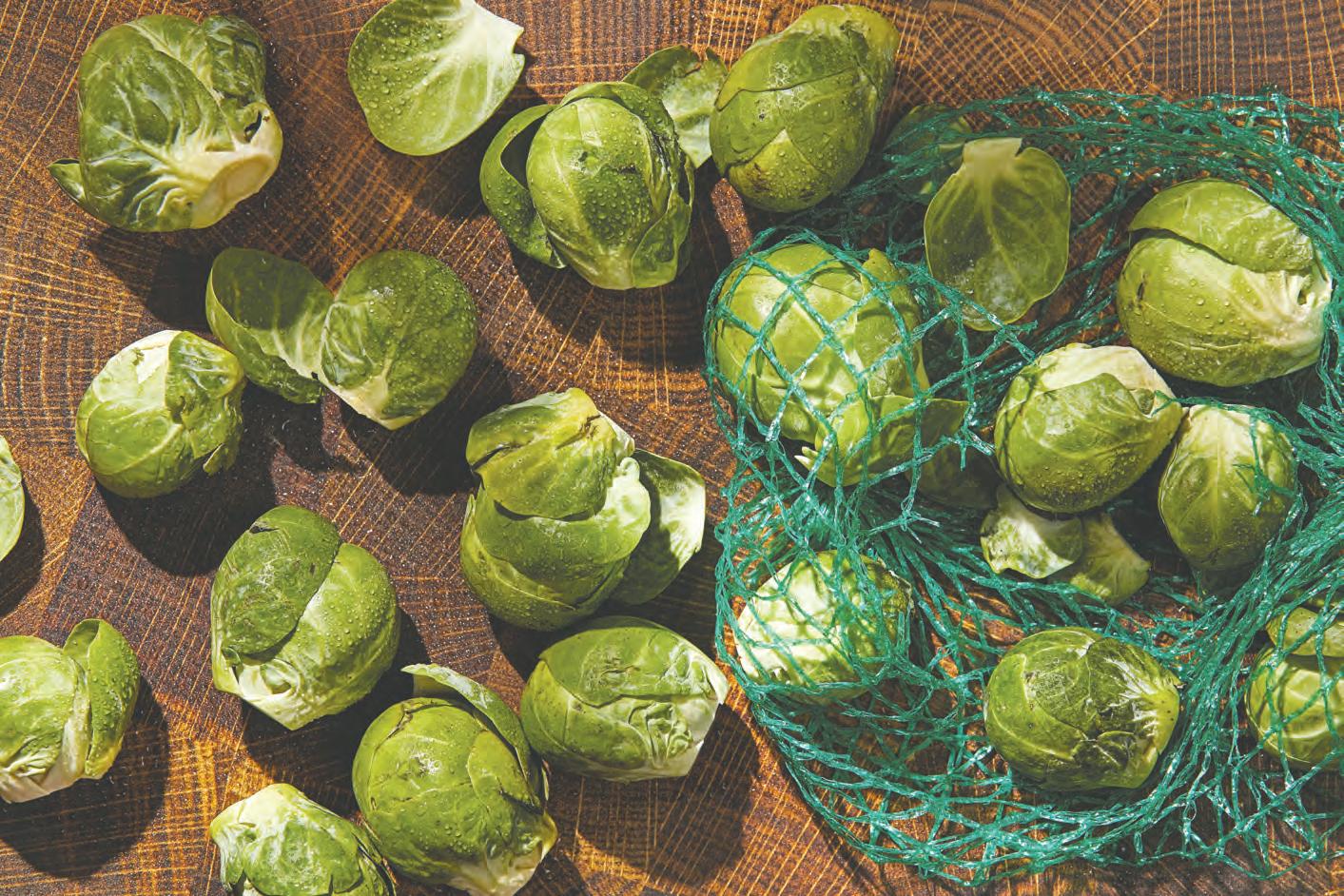B2 Monday, November 30, 2020 — DAILY REPUBLIC
A guide to Brussels sprouts How to choose, store, season, cook the versatile vegetable The Washington Post
A
recipe for “Brussels Sprouts Salad” published in The Washington Post in 1936 instructed the cook to combine boiled sprouts with salt, lemon juice and lettuce and then “cover with mayonnaise dressing,” promising it would be “a novelty at any dinner table.” Now, 84 years later, sprouts are as common as broccoli and kale, and the only still-novel thing about them may be how they grow. Gardeners and farmers market regulars will know the surprising, wondrous way Brussels sprouts look before they’re harvested: They bud atop the long leafed branches of a thick, almost two-foot-tall stalk. Nestled between stalk and branch, each sprout grows to between half an inch and just shy of two inches in diameter. Once harvested, the doll-size cabbages can be sold still attached to their stalks or, more commonly, in bags or cartons, ready for trimming and cooking. In North America, they’re generally available year-round, though they’re at their peak from early fall to early spring, and they’re sweeter after spending a frost on the stalk. Though they’re miniature cabbages, they’re not as sturdy as the larger variety, and benefit from more gentle care. Because they’re similarly bite-size, it’s tempting to treat Brussels sprouts like green beans or baby carrots, but they’re nothing alike when it comes to taste. Here’s how to pick and prepare them, whether you plan to serve them at a holiday feast or for a weeknight dinner.
Choose. If buying a whole stalk, check the spaces between the sprouts and the stalk for mold or dampness. On or off the stalk, look for sprouts that are compact, with tight leaves. You’ll be able to tell how freshly cut sprouts are by examining the stem end: It should look dry, but not brown or, worse, moldy.
Store. Marian Morash, writing in “The Victory Garden Cookbook,” calls Brussels sprouts “miniature perfection,” but notes that they “’ripen,’ picking up a strong flavor during storage, so it’s best to use them as soon as possible.” Chef, culinary activist and author Preeti Mistry notes that if you buy them on the stalk, you can keep them in a dry, cool place for a few days without having to refrigerate them. Once off the stalk, you’ll want to keep them in the fridge. Barbara Sibley, the chef and
Tom McCorkle/The Washington Post
Though Brussels sprouts are miniature cabbages, they’re not as sturdy as the larger variety and benefit from more gentle care. owner of La Palapa in New York City, watches the tender baby leaves that are on the outside of the bud; they’re especially sweet, and are the first to wither. “Sometimes I’ll put about half an inch of water in a shallow container and stand the sprouts up in it to keep them crisper,” Sibley says. “Though they’re hardy, remember that they’re plants, so treat them gently like the sprouts that they are.” To freeze, Morash suggests blanching washed and trimmed sprouts in boiling water for three to five minutes, depending on size, chilling on ice, draining and allowing to dry completely before freezing in bags or containers. Sprouts can then be seasoned and cooked right out of the freezer.
Cook. Like many other members of the cabbage family, Brussels sprouts can be eaten raw, shredded and dressed or marinated, especially when very fresh. If you’re buying them from the grocery store, or you know they’re more than a few days old, cooking – blanching, steaming, roasting, grilling or sauteing – will help temper some of their
strong flavors. Halved sprouts can be tossed in oil, salt and pepper and roasted until browned. Morash suggests cutting a small crosshatch into the trimmed ends before steaming or blanching so that their firm cores cook more quickly. Steamed sprout petals can be added to soups as a garnish; add blanched, quartered or halved sprouts to soups or stews in the final few minutes of cooking. Overcooking them tends to render them mushy and brings out their acrid flavors and smells. Both Mistry and Sibley note that one of the reasons many people tend to enjoy the Brussels sprouts they eat at a restaurant is because of a two-step cooking process: “Generally we’d parcook them, and then finish them to order,” Mistry says. “So I’ll cut them into quarters, roast just until they’re cooked through but not browned, and finish them on the stove to order. If you try to saute from raw, you end up steaming them instead of crisping or caramelizing.” To speed up the cooking process, you could cut them in half and then slice them into thinner pieces before sauteing quickly, Mistry says. They’ll
cook evenly in one pan, and can get crispy over high heat, though they’ll lose the varied texture they retain when cooked in larger pieces. “I like to put them in tacos, and not unlike a tender meat, I want there to be a nice bite left to them, right at the core,” Sibley says. “I’ll quarter them and give them a quick blanch, and then finish them in a pan.” That ensures they retain some texture and absorb any flavors added in the way of a sauce or seasoning.
Season. Some prefer their sprouts seasoned simply with salt and pepper, but the vegetable’s strong flavors mean they pair well with stronger or complementary seasonings and sauces. “You want to play to the sprouts’ strengths,” Sibley says. Sibley sautes quartered, blanched sprouts in a sauce made from chile de arbol (for heat) and chile ancho (for smokiness). “Once they’re cut and cooked just until tender, the core stays a little chewy and the leaves open a bit, leaving little gaps for the salsa to sneak into,” she says. Piled into a tortilla with queso fresco and crema, “it’s a
meaty taco without any meat.” At home, Sibley says she might use sweetness to offset the sprouts’ bitterness by halving and roasting them with piloncillo or brown sugar, lime zest, a neutral oil such as grapeseed, plus lots of salt and pepper. “Make sure they’re coated evenly, and roast them on really high, tossing or shaking the pan a little every 10 minutes, until they’re really crispy all over,” she advises. Mistry agrees that “really piquant spices go well with sprouts.” A recipe in their cookbook, “The Juhu Beach Club Cookbook: Indian Spice, Oakland Soul,” pairs sprouts with a curry leaf ginger butter, and Mistry likes to play around with tempering spicier flavors, say from mustard or chiles, with tangy notes from tamarind and citrus. “I would actually just use my mustard fenugreek spice blend, which has some heat but also a deep green herby-ness and some tartness,” Mistry says, noting that old Indian cookbooks refer to sprouts as baby cabbages, and suggest cooking them as such. “They want spice,” Mistry says, “They want tartness. They want flavor.”
Quinoa bake a clever way to reinvent leftover vegetables
W
hen this dish emerges from the oven, the first thing you notice is how gloriously cheesy it is, with an alluring, golden-brown crust of nutty, funky gruyere. Scoop into it and you get to the tender quinoa studded with pieces of autumnal roasted vegetables, all moistened and married in a light, creamy cheese sauce. Ellie Krieger It’s a FrenchNourish style gratin, in essence, but with an unconventional, more healthful twist centered on the Peruvian staple “grain.” That word is in quotes because while quinoa cooks up like a grain, it is technically a seed, with more protein, fiber and minerals than most grains. And while the cheesy richness of this bake calls like a siren, that’s because half of the cheese is strategically sprinkled on top, where it gets the most attention. Overall, it has a modest amount, as gratins go, and its sauce is more health-
fully milk-based instead of relying on cream. I like to use deep-hued red quinoa here, simply because I like how it looks, but the regular light brown type works all the same. And you can use any mix of roasted vegetables in this dish, too, making it especially handy post-Thanksgiving when you probably have some to use up. This bake is right at home served alongside roasted poultry or meat, but it is so satisfying it also hits the spot in a larger portion as a meatless main dish. Quinoa and Roasted Vegetable Bake With Gruyere Active time: 20 minutes Total time: 55 minutes 4 to 6 servings This bake is a French-style gratin in essence, but with an unconventional, more healthful twist centered on nutrient-rich quinoa and featuring a mix of roasted vegetables. While its alluring, golden-brown gruyere topping calls like a siren, overall, it has a modest amount of cheese, and its sauce is made with milk, not cream, so it’s lighter. The deep hue of red quinoa is especially appealing, but the regular light brown variety works all the same, and any mix of roasted
Tom McCorkle/The Washington Post
Quinoa and Roasted Vegetable Bake With Gruyere. vegetables may be used, making it a unique and sumptuous way to use up leftovers. Storage Notes: Leftovers may be refrigerated for up to 3 days. Olive oil, for greasing the dish 2 1⁄2 cups low-fat milk 2 1⁄2 tablespoons allpurpose flour 2 cloves garlic, minced or finely grated 1 teaspoon mustard powder 3 ⁄4 teaspoon sweet paprika 1 1⁄4 cups (4 ounces) shredded Gruyère cheese, divided 1 ⁄2 teaspoon kosher salt
⁄2 teaspoon freshly ground black pepper 3 cups cooked quinoa, preferably red (from about 3 ⁄4 cup/4 1⁄2 ounces uncooked) 3 cups roasted mixed vegetables (such as Brussels sprouts, carrots, cauliflower, squash), coarsely chopped Position a baking rack in the middle of the oven and preheat to 400 degrees. Brush a 1 1⁄2 - to 2-quart shallow baking dish with oil. In a medium saucepan over medium heat, whisk together the 1
milk and flour until the flour is dissolved. Add the garlic, mustard and paprika and, whisking constantly, bring the mixture to a gentle boil. Reduce the heat to medium-low and simmer, stirring a few times, until the mixture has thickened to the thickness of cream, about 2 minutes. Add half of the cheese, the salt and pepper, and stir until the cheese is melted and the mixture is smooth, then remove from the heat. Add the quinoa and vegetables to the pot and stir until combined. Transfer the mixture to the baking dish. Top with the remaining cheese and bake for 25 to 30 minutes, or until the mixture is bubbly and the cheese on top is nicely browned. Let cool for 5 minutes before serving. Nutrition (based on 6 servings): Calories: 298; Total Fat: 12 g; Saturated Fat: 5 g; Cholesterol: 25 mg; Sodium: 296 mg; Carbohydrates: 34 g; Dietary Fiber: 5 g; Sugar: 3 g; Protein: 15 g. Recipe from dietitian and food columnist Ellie Krieger.
Ellie Krieger is a registered dietitian, nutritionist and author who hosts public television’s “Ellie’s Real Good Food.” She blogs and offers a weekly newsletter at www. elliekrieger.com.







